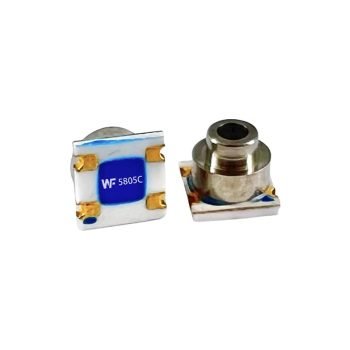Каталог
As smart systems demand higher data accuracy and faster response, sensor chips become critical in information sensing. Linearity ensures output accuracy, while sensitivity governs the detection of minute changes. This article, from a MEMS pressure sensor chip design perspective, defines both metrics, analyzes their impact in various applications, proposes targeted design strategies, and discusses how to balance high linearity and sensitivity in practice.
Overview of Linearity and Sensitivity
Определить диапазон измерения & Точность
A typical sensor chip comprises a silicon diaphragm, piezoresistors, and a bridge circuit. External pressure deforms the diaphragm, changing resistor values and producing a differential voltage at the bridge output.
Defining Linearity
Linearity measures the deviation between sensor output and input pressure, usually expressed as Maximum Nonlinearity Error. Ideally, the output varies strictly linearly with pressure.
Understanding Sensitivity
Sensitivity quantifies output change per unit pressure, in mV/V/kPa or LSB/kPa. Higher sensitivity means the sensor detects finer pressure fluctuations.
Interdependence of Metrics
Although independent, linearity and sensitivity interact in design and testing. Boosting sensitivity can expand non-linear regions; improving linearity must consider post-amplification noise.
Impact in Key Applications
Precision in Medical Devices
In blood pressure monitors and ventilators, linearity ensures the physiological signal accurately reflects patient status, while sensitivity captures end-of-breath or weak pulse signals.
Challenges in Industrial Automation
Harsh conditions—high temperature, vibration, corrosion—test sensor reliability. Stable linear output aids precise control, and high sensitivity enables early fault detection for predictive maintenance.
User Experience in Consumer Electronics
In wearable bands and smartphone barometers, high linearity prevents data drift, and superior sensitivity improves instant feedback for altitude changes or touch-pressure detection.
Data Fusion in IoT Networks
In distributed sensing, output accuracy influences fusion algorithms’ convergence and reliability. Consistent linear calibration and high-speed sampling support synchronized multi-node data capture.

Strategies to Improve Linearity
Analog Circuit Enhancement
Use high-linearity amplifiers and differential stages. Implement negative feedback to cancel non-linear errors and maintain proportional bridge output.
On-Chip Digital Calibration
Embed lookup tables and linearization algorithms for real-time correction. Polynomial fitting or table-based compensation sharply reduce maximum non-linearity.
Structural Optimization and Materials
Simulate diaphragm thickness, beam geometry, and strain concentration to fine-tune mechanical response. High-purity single-crystal silicon minimizes lattice defects for consistent elasticity.
Temperature Drift Mitigation
Integrate on-chip temperature sensors and compensation networks. Dynamically adjust output across –40 °C to 125 °C to maintain linear performance.
Paths to Higher Sensitivity and Adaptability
Noise Reduction Techniques
Optimize PCB layout, shield critical nodes, and choose low-noise differential amplifiers. These steps enhance SNR and reveal subtle pressure changes.
Microstructure Refinement
In MEMS diaphragms, shortening beam length or thinning membranes increases strain, boosting output amplitude and sensitivity.
Multi-Stage Gain and AGC
Design cascaded amplification with automatic gain control (AGC) to adapt total gain across pressure ranges, balancing high sensitivity and wide dynamic range.
Adaptability and Reliability
Chips validated by temperature cycling, shock, and aging tests maintain performance in extreme conditions. Compact packages and versatile interfaces suit diverse industrial, medical, and consumer environments.
Implementation and Co-Optimization
Balancing Design Priorities
Allocate error-budget between sensitivity and linearity. A hybrid approach—non-linear correction plus dynamic gain control—yields both precision and responsiveness.
Sensor Fusion with Smart Algorithms
Apply Kalman filtering or Bayesian inference to merge pressure, temperature, and humidity readings, improving overall measurement robustness and accuracy.
Analog–Digital Hybrid Architecture
Integrate an analog front end (AFE) for initial amplification and filtering, and a digital signal processor (DSP) for precise calibration and noise suppression in real time.
Rapid Validation and Scale-Up
Provide standardized evaluation kits and software drivers to shorten development time. Batch consistency testing ensures stable performance in mass production.
Заключение
This article explored MEMS pressure sensor chip linearity and sensitivity, detailing definitions, application impacts, and design strategies. By combining advanced fabrication with smart algorithms, engineers can achieve ±0.05%FS linearity and mV/V/kPa-level sensitivity in compact, low-power chips, delivering reliable solutions for medical, industrial, and consumer markets.
Вышеупомянутое введение лишь поверхностно коснулось области применения технологии датчиков давления. Мы продолжим изучать различные типы сенсорных элементов, используемых в различных продуктах, их работу, их преимущества и недостатки. Если вам нужна более подробная информация о том, что здесь обсуждается, вы можете просмотреть соответствующий контент далее в этом руководстве. Если у вас мало времени, вы также можете нажать здесь, чтобы загрузить подробную информацию об этом руководстве. Данные датчика давления воздуха PDF.
Для получения дополнительной информации о других сенсорных технологиях, пожалуйста, Посетите нашу страницу датчиков.
